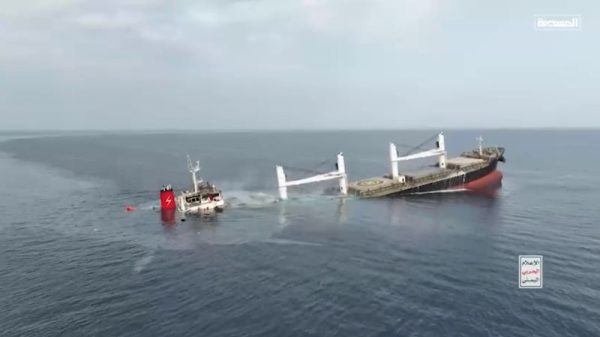There was no shortage of false claims and exaggerations offered by former president Donald Trump during his conversation with Elon Musk on Monday night. Working feverishly, fact-checkers might be able to publish a delineation of all of them shortly before the heat death of the universe.
But there was one claim that seemed as though it deserved its own special place in the spotlight. One claim that, while not a new element of Trump’s repertoire, is such a good encapsulation of his general approach to reality that walking through it seemed as if it might offer readers some useful insights into both Trump and the state of the world.
Musk and Trump were talking about geopolitics when Trump pivoted to discuss existential global dangers — in his fashion.
“The biggest threat is not global warming, where the ocean’s going to rise one, one-eighth of an inch over the next 400 years. The big — and you’ll have more oceanfront property, right?” the former president said. “The biggest threat is not that. The biggest threat is nuclear warming, because we have five countries now that have significant nuclear power, and we have to not allow anything to happen with stupid people like [President Joe] Biden.”
We can start by noting that there are nine, not five, known nuclear powers, the sort of thing that former presidents might generally be expected to estimate more precisely. But our focus here is not nuclear weapons but, instead, Trump’s claims about sea levels.
Trump often dismisses the threat posed by rising sea levels by suggesting that they are minor or insignificant. Speaking to Musk, it was an eighth of an inch over 400 years; how could anyone be worried about that?
But that is nonsense.
“Global mean sea level increased by 0.20 (0.15 to 0.25) m between 1901 and 2018,” the United Nations Intergovernmental Panel on Climate Change wrote last year. “The average rate of sea level rise was 1.3 (0.6 to 2.1) mm yr between 1901 and 1971, increasing to 1.9 (0.8 to 2.9) mm yr between 1971 and 2006, and further increasing to 3.7 (3.2 to 4.2) mm yr between 2006 and 2018 (high confidence).”
Putting that in American, sea levels rose nearly eight inches from 1901 to 2018. From 1901 to 1971, the rise occurred at a rate of about 0.05 inches a year. That increased to 0.07 inches until 2006 and since has jumped to 0.15 inches. In other words, sea levels are rising at more than an eighth of an inch annually, not over the next four centuries.
The National Oceanic and Atmospheric Administration explains that “about 2 feet (0.6 meters) of sea level rise along the U.S. coastline is increasingly likely between 2020 and 2100 because of emissions to date. Failing to curb future emissions could cause an additional 1.5 – 5 feet (0.5 – 1.5 meters) of rise for a total of 3.5 – 7 feet (1.1 – 2.1 meters) by the end of this century.”
The “emissions” being referenced, of course, are greenhouse gas emissions, releases of carbon dioxide, methane and other gases that help trap heat in the atmosphere. The rise in the rate of increase in sea levels reflects that trapped heat in two ways. First, warmer temperatures accelerate the melting of glaciers and other ice that then flows into oceans. Second, warmer temperatures increase ocean temperatures, and warmer water occupies more volume than colder water.
As shown in this NOAA graph:
Okay, Trump argues, but that just means more oceanfront property! Win-win!
Believe it or not, Trump is wrong again. If you have a defined area of land that’s surrounded by water, an increase in the height of the water means that it covers more land. The result is less land touching the ocean, not more.
The illustration above is exaggerated, obviously, but we can do some simple math to prove the point.
There are 95,471 miles of shoreline in the United States, including outlining American territories. Imagine, for the sake of simplicity, that’s a big circle, as above. The 95,471 miles would be its circumference, the distance around its outside edge. Its diameter — its width across the middle — would be about 504,086,880 feet. Now slice off two feet at each end, marking the anticipated sea-level rise by 2100. (A rise of two feet in sea level doesn’t necessarily mean that it eats into the shore two feet, but this is just an example.) Now the circumference (the diameter times pi) is 504,086,867 feet. About 13 fewer feet of shoreline!
On the scale of the United States, this is not a big shift, but it highlights the point. A big spike in sea levels would almost certainly reduce the amount of oceanfront property — though it would add new oceanfront property.
But this isn’t how sea-level rise actually manifests in a problematic way. NOAA has an interactive tool that allows you to see the effects of various increases of sea levels in coastal areas around the country. Below, you can see the difference in Charleston, S.C. — which recently saw flooding linked to Hurricane Debby — between the average height of the highest tide and an increase of two feet in sea levels. Notice, for example, the extension of inlets at the left side of the image.
The problem in Charleston, though, is that sea-level rise has already made flooding more common during high tides. On its map of high-tide flooding, you can see the extent to which inundations are already regularly a problem.
Various places around the United States, including near Trump’s home in Florida, now regularly see “sunny day flooding” that’s largely a function of higher sea levels. About seven days a year, Charleston sees this sort of flooding. By 2050, it’s estimated that it will happen at least 70 days a year. (NOAA’s explanation of how different factors combine to cause floods is worth your time.)
The issue isn’t that sea levels will rise and old beachfront property will magically be replaced with new beachfront property. It’s that flooding will become more common and increasingly problematic — and make the effects of big storms far worse. It is not a “Hey, more beach clubs for the Trump Organization!” situation.
Trump’s rhetoric isn’t a sober analysis of NOAA data, of course. (In fact, Project 2025, the set of policy proposals written by the Heritage Foundation and various former Trump staffers, recommends dismantling NOAA entirely.) It is, instead, a way to shrug at the risks posed by climate change or to spin them as a positive.
It’s a bold indifference for a guy who lives next to the ocean to present.






































